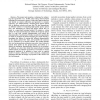Free Online Productivity Tools
i2Speak
i2Symbol
i2OCR
iTex2Img
iWeb2Print
iWeb2Shot
i2Type
iPdf2Split
iPdf2Merge
i2Bopomofo
i2Arabic
i2Style
i2Image
i2PDF
iLatex2Rtf
Sci2ools
ICRA
2008
IEEE
2008
IEEE
Memory-based learning for visual odometry
Abstract— We present and examine a technique for estimating the ego-motion of a mobile robot using memory-based learning and a monocular camera. Unlike other approaches that rely heavily on camera calibration and geometry to compute trajectory, our method learns a mapping from sparse optical flow to platform velocity and turn rate. We also demonstrate an efficient method of computing high-quality sparse optical flow, and techniques for using this sparse optical flow as input to a supervised learning method. We employ a voting scheme of many learners that use subsets of the sparse optical flow to cope with variable dimensionality and reduce the dimensionality of each learner. Finally, we perform experiments in which we examine the learned mapping for visual odometry, investigate the effects of varying the reduced dimensionality of the sparse optical flow state, and quantify the accuracy of two variations of our learner scheme. Our results indicate that our learning scheme estima...
| Added | 30 May 2010 |
| Updated | 30 May 2010 |
| Type | Conference |
| Year | 2008 |
| Where | ICRA |
| Authors | Richard Roberts, Hai Nguyen, Niyant Krishnamurthi, Tucker R. Balch |
Comments (0)

